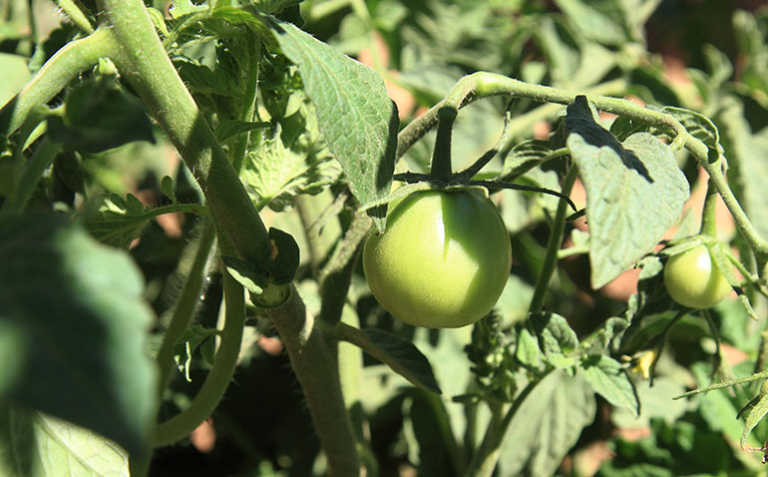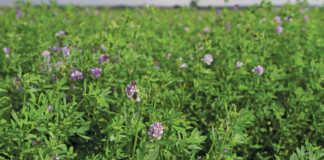
Photo: Glenneis Kriel
As reported in a previous article, farmers in the Olifants River Valley have been forced to seek alternative means of generating income due to wine grape prices remaining fairly static over the past 12 years.
Karl van Rensburg of the farm Laborare, near Trawal, has begun experimenting with peach production on a small scale, but says it is still too early to talk about his findings.
However, if all goes well, fruit from these orchards will be the earliest variety to be ready for the Western Cape market, possibly in October.
Sultanas and currents
In addition to peach production, Karl has been replacing vineyards with grapes for the raisin market. Diversifying into these has been relatively easy, he explains, as the management practices are similar to that of wine grapes.
“Raisin production is also attractive because it’s labour-intensive, requiring hand pruning and harvesting.”

According to Karl, some producers are shying away from labour-intensive crops due to rising costs and management challenges.
In contrast, farmers near Trawal are looking for ways to create sustainable job opportunities as they are aware of the social impact of unemployment on their surrounding communities.
While wine grape production averages about 25 t/ ha in the region, grape varieties for the production of sultanas and currents produce full commercial yields of 40t/ha to 60t/ha after three years.
By the second year of production, these vines already produce half this yield.
The cost of production is higher at about R57 000/ha, due to more intensive labour requirements and the need for drying, compared with R37 000/ha for wine grape production.
However, turnover is two to three times higher.
Another advantage is that a producer receives payments soon after delivery. “We pick, dry the grapes for two weeks, deliver it to the client, and a week later we’re paid. Wine grape producers, on the other hand, have to wait up to 18 months to be remunerated,” Karl says.
Tomatoes
To boost income, Karl also plants tomatoes, which he delivers to the fresh produce market.
These are planted beneath young vines, so that plants and vines share the same irrigation and trellis systems.
“One might expect this practice to have a negative impact on the vineyards, but it doesn’t if it’s carried out properly. My sultana and current vineyards still produce at least half their commercial yields 18 months after planting, in spite of tomatoes being planted underneath them during their first year of production,” he says.
Nevertheless, the tomatoes are planted only in newly established vineyards, as older vineyards will overshadow the plants, causing fruit set problems.
Young vines are planted in September, and tomato seedlings are planted at a density of 10 000 plants/ha in early December. The young vines require at least 90 days of growth after establishment before the tomato seedlings are planted.
“The first 90 days of a young vineyard’s life are the most important. Any mistakes, and the vines will struggle to catch up. A year can be lost in the process. So we ensure that we do everything right, from soil preparation to the planting of the vines. The vineyards must also be kept weed-free,” explains Karl.
Vegetables should not be planted on clay soil beneath vines as this can cause compaction.
Irrigation and fertilisation must also be adapted to accommodate the requirements of the vines and tomato plants.
READ Can marigolds control eelworm?
“The irrigation system must have the capacity to supply enough water for both crops,” Karl says.
As a rule of thumb, he increases the tomato plants’ fertigation programme by 15% to 20% to accommodate the requirements of the vineyards.
The fertilisation programme is based on the results of soil analysis. Drippers with a delivery rate of 2,3mm/ha are used. Plants must be inspected regularly and treated for red spider mite, early and late rust, and bollworm. Tomatoes are harvested by
Tomatoes are harvested by hand towards the end of February. Production volumes vary between 85t/ ha and 120t/ha, which helps fund the establishment costs of the vineyards.
‘Stick to what you know’
To counter market fluctuations, Karl plants 64% of the farm to wine grapes, 18% to grapes for raisin production, and 18% to tomatoes.
He did consider citrus production, but decided against it as citrus orchards need almost double the volume of water required by vineyards. He is also unfamiliar with the crop, and for the same reason has avoided planting other cash crops or vegetables in vineyards.
“I try to stick to crops I know. We’ve been producing tomatoes and wine grapes since I started farming 20 years ago,” he says.
In addition to planting tomatoes in the vineyard rows, Karl also plants 15ha in open lands and 4ha undercover every year.
He believes that farmers should not allow the markets to dictate what they plant.
“Most markets are cyclical in nature; they all have their ups and downs. A farmer has to choose the crop he’s going to focus on and commit to it, especially when producing long-term crops that take four to five years to reach commercial production levels, but only have a 25-year lifespan. What is hot today will not necessarily be tomorrow’s sweetheart,” he stresses.
Karl also emphasises the importance of having a secure market before venturing into a new field.
“Many farmers think they can boost farm income with tomatoes, but there’s a lot of competition in the market. If you’re unable to produce good quality throughout the year, you’re probably better off producing something else,” he says.
Email Karl van Rensburg at [email protected].













